21
View of Collie Woollen Mill from the dam on the Mississippi River in 19461946
Appleton, Town of Mississippi Mills, Ontario, Canada
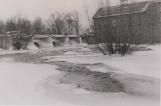 Credits:
Credits:Mississippi Valley Textile Museum (2011.39.14)
Donated by Isobel Collie in memory of her husband Jack Collie
22
The Collie's were very fortunate to have built a new building in 1940 because they soon suffered two devastating fires. In either 1945 or 1946 the old stone mills were partially destroyed by a fire. After the fire the inside of the old mill was rebuilt and again became the finishing department and the administration offices. Only five years later, in 1950, an even larger fire struck completely gutting the buildings. The massive amount of damaged convinced William Collie to abandon the stone mills and instead build an addition to the "upper mill."Please see the storyline: "Collie Woollen Mill Fires: 1946 & 1950" for the full story
23
Black and white view of Collie Woollen Mill from the river, 19461946
Appleton, Town of Mississippi Mills, Ontario, Canada
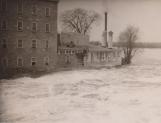 Credits:
Credits:Mississippi Valley Textile Museum (2011.39.30)
Donated by Isobel Collie in memory of her husband Jack Collie
24
With about 300 employees at the peak, the mill was a big industry in the Town. After the war the mill ran three shifts 24 hours a day. Many of the employees found cheap rent at the various houses owned by the Collie family, including the former Robert Teskey house which was used as a boarding house.
For the many employees who lived in Almonte or Carleton Place the mill operated a bus that drove daily to Carleton Place and Almonte to bring workers to the mill. The local Appleton children would often catch a ride on the Collie bus to Carleton Place to watch a film or go shopping.
25
Shuttle from a weaving loom and bobbin from a spinning frameCirca 1937-1987
Appleton, Town of Mississippi Mills, Ontario, Canada
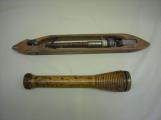 Credits:
Credits:Courtesy of Irene (Dunn) Thompson
26
The Collie Woollen Mill produced woven woollens, mainly for clothing manufacturers. Just like prior owners at the woollen mill, the Collie's had to bring in raw wool from outside sources as the local farmers couldn't fill the mill's demand.27
Edith Dowdall and daughter Fay wearing coats made with Collie Mill fabric. Photo by Malak Karsh1945-1946
Appleton, Town of Mississippi Mills, Ontario, Canada
 Credits:
Credits:North Lanark Regional Museum (2012.79.12.31)
Photographer: Malak Karsh
Donated by Eleanor Wright & Irene Dunn Thompson
28
In the late 1950s and 1960s woollen goods decreased in popularity as consumers turned to polyester and synthetics. Following the demand, the Collie Mill began working with polyesters and synthetics, bringing in the fibres from Montreal and then dying, spinning and weaving them.The mill produced fleece for baby blankets and produced material for house coats, teddy bears, and upholstery.
29
Another product the mill began to produce was pile (fake fur) used for lining winter coats and other goods. In order to make this new product, staff (new and old) had to be trained on the new techniques and machinery. Demand for pile created a busy summer season as staff tried to fill the fall demand of clothing manufacturers preparing for the winter season.Pile also opened up a whole new market for the company. In the late 1970s Collie Woollen Mills began exporting to the Far East. The low Canadian dollar and the low labour content involved in making pile made exporting to countries like South Korea economical. This new venture helped increase sales and jobs at the mill. In 1979 the company went from 190 employees to 225 and went from $9 million in sales in 1978 to predicting sales of $18 million in 1980.
30
Ottawa Valley Fabric Company exports products to Far East14 November 1979
Appleton, Town of Mississippi Mills, Ontario, Canada
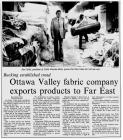 Credits:
Credits:Google News Archive, Ottawa Citizen, November 14, 1979
31
Santa Tuque and Teddy Bear made using Pile produced at the Collie Woollen MillsCirca 1980s
Appleton, Town of Mississippi Mills, Ontario, Canada
 Credits:
Credits:Courtesy of Irene (Dunn) Thompson
32
Stool made with upholstery fabric manufactured at the Collie Woollen MillsCirca 1980s
Appleton, Town of Mississippi Mills, Ontario, Canada
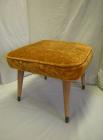 Credits:
Credits:Courtesy of Irene (Dunn) Thompson
33
In addition to selling to large manufacturers, the Collie Woollen Mills also sold directly to the consumer. The article "Appleton: A storybook town" by Colleen Anderson Kong (Ottawa Journal T.V. Guide, May 31, 1980 ) discusses a factory-outlet store run by Collie Woollen Mills."[...] the present-day Collie Woolen Mills Ltd., [is] known by bargain-conscience consumers all over the Valley and Ottawa for its factory-outlet store where fleece fabrics, velours, knits and upholstery fabrics sell for about $1.20 to $2.50 a yard, with specials such as the 55 cents a pound pieces."
34
In about 1948 William Collie decided to retire and left his sons to manage the mill. His son James E. Collie took over management of the business and later William's grandson James S. Collie joined the business along with Ralph Brown, son-in-law of James E. Collie.The 1980s were tough financial years for the Collie Woolen Mills. Supplies such as poly-cottons and acrylic yarns were hard to get and the economy was moving towards overseas labour and production. In 1987 the company went into receivership and the Ontario Development Corporation became the legal owner in April 1987.
In August 1987, under new owners, the mill reopened as a numbered company, 724597 Ontario Limited, and operated under the name 'Appletex'. The mill continued to struggle financially. New investors came forward in 1989 injecting capital into the business however, in March 1992 all operations ceased and the premises were abandoned.